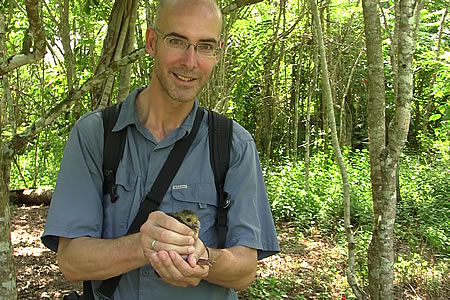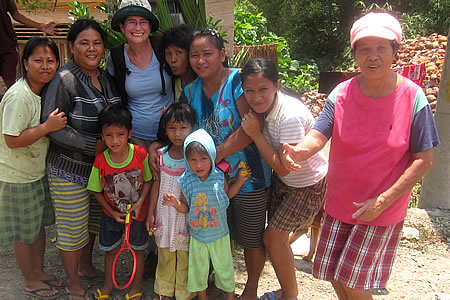

| Birding at auntie Mien | |
Sinsingon (Indonesia), April 24th 2012
|
|
|
|
|
Auntie Mien (Tante Mien) is famous among birders who once travelled to the northern part of the Indonesian island Sulawesi (formerly known as Celebes). Auntie Mien is a home stay in the small village Duloduo, located between the bigger cities Manado (6 hours by bus) and Gorontalo (8 hours by bus). Duloduo is situated on the fringes of Banani Nani Wartabone National Park and is for that reason a great base to visit the park. It is a typical destination for birders, because ‘normal’ tourists seldom visit this remote national park. Home stay Auntie Mien is run by Auntie Mien herself and her husband. A stay at this place can be called a feast, because the rooms are comfortable, the food is delicious and the hosts are great. During the afternoon of the day we arrived, we wandered in the area around the village. The local people are not really used to foreigners in their tiny little village and we notice that our presence is a big happening for them. Big smiles appear on their faces when we walk by and motorcycle drivers almost crash when they turn their heads while driving to see what is going on. Children are extremely excited while pointing at us and yelling ‘buleh’, what is a general term in Indonesia for foreigners, while teenage girls shout out to Edwin “I love you” and “I miss you”, which is a indisputable proof that the villagers are somewhat upset. We walk to a part of the national park that we visited before in 2008 and we soon notice that a lot has happened the last few years. Parts of the forest where we saw great birds, where deforested and changed into agricultural fields where scarecrows nowadays keep the former inhabitants of the forest on a distance. The stories that we often read in the news about the continuing deforestation of Indonesia is definitely true. We have seen it now with our own eyes. |
|
 |
|
Edwin and the one-day old Maleo chick |
|
Early next morning we took an ojek (motorcycle taxi) to Toraut, a part of the national park where most birders go when they bring a visit to this park. It is a 12 kilometre ride and this is also the place where the ranger station is located. It is also one of the most accessible parts of the park. But also this part of the park is threatened by advancing agriculture. A small river separates the park from the fields and it seems only a matter of time before also Toraut is ‘swallowed’ by fields and plantations. We agreed with Hendrik, the main ranger, to take us to the park to see what birds we can find. Hendrik is not really fanatical and with a lot of effort we manage to find only 21 different species of birds during the whole morning, including the Pied Cuckoo-Shrike, the Ashy Woodpecker and the Maroon-chinned Fruit-dove. It is mandatory to take a guide, which means that Hendrik doesn’t have to do a lot to get customers. So, getting tired isn’t necessary is what he probably thinks. During our second full day of our visit we took an ojek at five in the morning to Tambun, on approximately 20 kilometres from Auntie Mien. Tambun is also famous among birders, because this is one of the last places left to see the Maleo bird in the wild. Officially, Tambun is part of the national park, but the reality is that Tambun is separated from the park by, indeed, fields and plantations. Only 5 hectares of the Tambun forests are left, and the only reason that this part survived is because of the fact that around 50 Maleo birds still live in this forest. The Maleo is a very special bird. The chicken-kind of bird does not hatch the eggs herself, but uses geothermal warmth to do it. She buries her eggs in sand that has a constant temperature of around 30-35 degrees Celsius. She has the skills the find the right spot and determines how deep she must bury the eggs to reach the perfect temperature. The Tambun forest has a hot spring which means that thermal warmth is available to hatch the eggs. After around 60 days, the chicks are hatched and the chicks dig themselves upwards after which they rise from the earth. There is nobody to take care for them, so for survival they are completely depending on themselves. But they have one big advantage; they can immediately fly. |
|
 |
|
Ivonne with a group of very enthousiastic village people near Duloduo |
|
| Also in Tambun, a park ranger is mandatory and Max is the one that guides us through the park. It doesn’t take long before we spot our first Maleo birds in the trees. What a fantastic bird to see. Max tells us that a colleague-ranger (a former poacher) tries to find the new nests on a daily basis to dig up the eggs. Subsequently, the eggs are buried again in a guarded place, in exactly the right conditions, to prevent that the eggs are excavated by wild dogs or monitor lizards. The reality is however, that habitat destruction is the main cause and that the eggs mainly need to be guarded from villagers who dig up the eggs to sell them in the market. We as humans first almost destroyed the species, and now it is fully depending on us. That’s the way is normally goes in the human world; action is only undertaken when it is already too late. Our visit to Tambun got a great ending for us. Max gave us the opportunity to hold a 1-day old Maleo chick to release it in the forest. When Ivonne opened her hand, the chick was a little bit confused in the beginning, but it didn’t take long before it opened its wings to fly into the forest.
During the third day of our stay we took again a very early morning motor taxi to the so called Malibagu Road. Malibagu Road is the road between Duloduo and the village of Malibagu, and it intersects a part of Banani Nani Wartabone National Park and is for that reason a great place to watch birds. We decided to ask the ojek to take us fifteen kilometres along the road, form where we walked back to Duloduo. The area is hilly, which means that you have sometimes great views over the canopy of the jungle, a great way to see canopy birds. Another great advantage of Malibagu road is that you don’t need a guide, which means that you can bird all by yourself. It was going to be a very nice day. We saw many birds including extensive views on the Knobbed Hornbill, White-necked Myna, Spot-tailed Goshawk, Pygmy Hanging-parrot, Sulawesi Serpent-eagle, White-backed Woodswallow, two endemic species of Flowerpeckers and four different species of Sunbirds. Despite the fact that the forests of Banani Nani Wartabone National Park around Duloduo are degrading in a fast pace, it is still an interesting place to go bird watching. The birding is often slow, but at the end of the day you probably still have a list of very interesting birds. We especially liked Malibagu road because it gives you the possibility to go by yourself and it has a wide range of species that you will also find in the official parts of the park. Unfortunately, the road can be a little busy, which means that you often have make place for the traffic. Passing vehicles will undoubtedly hit their horns when they see ‘bulehs’, and ‘hello mister’ are certainly the words that you hear most often that day, regarding being male of female. But unless these small drawbacks, you should give it a try. © copyright - Babakoto.eu / 2012 |
|